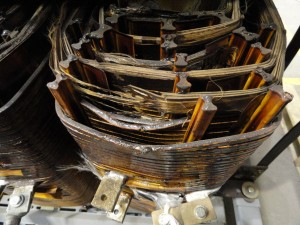15 Second Test Reveals 1500 Kva Transformer Failure
An Electrical Contractor called MIDWEST with an emergency. A customer lost a 1500 kva dry type power transformer. The voltage was 13,200 to 480. Two of the fuses in the primary load break switch had blown. They checked things out and couldn’t find anything wrong, but wanted MIDWEST to test the transformer anyway. Meanwhile they checked out the secondary switchgear and a 480 volt to 208 volt dry type transformer in the same room as the switchgear. They found no smell and no smoke, so they figured they might get lucky, although we both knew that was not very probably. When 15kv, 100 amp fuses blow, a lot of energy went somewhere. The 1500 kva dry type transformer was a typical indoor unit substation type, with LAs, cooling fans and a fan control package. When we got there, the electrical contractor already had the panels off the switchgear and transformer, and everything properly grounded. They offered to help haul up the test equipment, which is always nice, but we said to hold off for a minute. It took 15 seconds to get our flashlight and then it took another 15 seconds to inspect the transformer and tell them the transformer had failed and they needed to get a replacement transformer or a rental transformer. Their skepticism was obvious, and for good reason. But we showed them the debris that had blown out the bottom of the center high voltage winding. Then had them look down through ventilation ports of the blown high voltage winding so they could see the blown out turns within the high voltage winding. They understood immediately. We ran a quick turns ratio test to document the failure. A case of seeing is believing.
